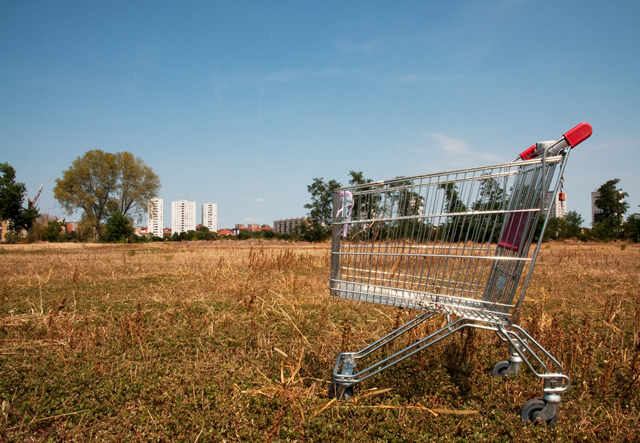Online Grocery Shopping Sadly Not A Food Desert Panacea
By Melissa Wiley in Food on May 13, 2014 6:00PM
Grocery stores, schmocery stores. That’s RedEye Zach Stafford’s conclusion after giving Chicago’s food deserts some superficial thought. Stafford found salvation in Instacart—“through the simple magic of its app and website”—after his dearly departed Dominick’s left him high, dry and slightly simpatico with those who never had a neighborhood grocery to miss. He sees no reason, then, why online markets shouldn’t serve everyone else equally well. The only problem? There are food deserts and there are food deserts. Often classified as areas where residents live more than a mile from a big-box grocer, not all food deserts are low-income. Some desert dwellers fall prey to inconvenience but not hunger. Those in the latter camp, however, can’t afford cold cuts at a click.
“The best solution to food insecurity and hunger is a good job that gives a person the means to put food on their table every day. But continued high unemployment and underemployment limit the ability for hundreds of thousands of our neighbors to purchase nutritious food. The viable solution in the immediate future is a strong safety net that gives struggling people access to food with critical anti-hunger programs like SNAP, WIC, summer meals for children and school breakfast and lunch,” Jim Conwell of the Greater Chicago Food Depository told Chicagoist.
Conwell goes on to define a food desert more broadly than government sources, as an area with low access to healthy food options. “Access could be limited because there is no full grocery store or fresh produce is scarce,” he concedes, “but access could also be limited because a large number of residents cannot afford healthy food options.”
It’s by conflating the two that Stafford makes his mistake and thus poses a specious recourse for the nearly 800,000 Cook County residents who qualify as food insecure, meaning, in Conwell’s words, they remain "uncertain when or where they might receive their next meal.”
Instacart, Peapod and the like, Stafford forgets, are in business for a reason, passing the buck onto consumers and profiting from doing the heavy lifting. It’s a buck that higher-income earners in higher-rent food deserts may be able to afford but those dependent on government benefits can’t. Were WIC or SNAP supplementing delivery services of this kind, Stafford may have found his panacea. As it is, faster WiFi is no help in kitchens where meal planning pivots on government checks.
In October 2012, Mayor Rahm Emanuel famously partnered with First Lady Michelle Obama for a high-profile food summit resulting in a welcome rash of farmers’ markets and community gardens across low-income areas, many on Chicago’s South Side, where residents often lack for fresh produce and suffer higher rates of obesity and diabetes as a consequence. By August 2013, Emanuel claimed to have cut food deserts by 21 percent over the past two years. But his claim is a debatable one. There's also more than Dominick's disappearance to blame for the problem's ballooning scale.
The Healthy Food Financing Initiative, an outcrop of the first lady’s healthy warrior cry, has since distributed more than $500 million across the country. Meanwhile, the Obama administration has rolled back SNAP money to pre-stimulus levels, further removing a growing segment of the population from Instacart’s reach and providing a food-insecure family of four an average of $36 a month less for groceries, according to Conwell.
The November 1, 2013 SNAP cutbacks also coincided with the expiration of long-term unemployment benefits and food’s continued rising cost, making the food-insecure further dependent on food banks and programs like Recipe for Healthy Places, a collaboration between the City of Chicago and the Greater Chicago Food Depository, also busy actively expanding the scope of its mobile pantries. But even the fleetest food banks can’t keep pace with this many hungry mouths.
“Over the last six years, we’ve seen a dramatic increase in need that affects every neighborhood and suburb in our community. The number of individuals served at food pantries in Cook County has increased by 70 percent since 2008,” Conwell added.
And then there’s Dominick’s, the ghost of which continues to challenge more creative solutions.
In the wake of the mega-chain’s demise, its former competitors still present themselves as the obvious answer. Part of the reason for this, however, may be the fact that conventional grocers' philanthropic arms sponsor much of the research on food deserts, citing themselves as the obvious solution, with an eye to landing more tax breaks by settling in impoverished communities. The City of Chicago’s definition of food deserts also shirks smaller retailers, specifying that the grocery store within a mile from your home must occupy more than 10,000 square feet for you to be immune to food drought.
Stafford, we at least know, isn’t profiting from seeking succor in the digital realm. Low-income food deserts, he also aptly notes, usually lack for the green space that brick-and-mortar markets would only supplant for yet more concrete. Green space, we’re prepared to admit, is a good thing. But pretty scenery falls lower on the totem pole on an empty stomach. So his heart may be in the right place, but if Chicago’s food deserts teach us anything, it’s that good intentions alone mean little where there’s no place to buy bananas.
